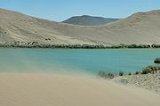
Bruneau Dunes State Park
Encyclopedia
Bruneau Dunes State Park is a state park
of Idaho
, USA, featuring several large sand dune
s and a small lake. The park is located south of Mountain Home, Idaho
, outside of Bruneau
. The park is the site of North America's highest single-structured sand dune which is approximately 470 feet (143.3 m) high. The park is also the site of the Bruneau Dunes Observatory, where visitors can use a telescope
for stargazing
.
The dunes at Bruneau Dunes State Park are unique in the Western Hemisphere. Other dunes in the Americas form at the edge of a natural basin. The Bruneau dunes form near the center. The basin has acted as a natural trap for over 12,000 years. The dunes may have started with sands from the Bonneville Flood
about 15,000 years ago. The prevailing winds blow from the southeast 28 percent of the time and from the northwest 32 percent of the time, keeping the dunes fairly stable. Unlike most dunes, these do not drift far.
. No vehicles are allowed on the dunes but climbing, sledding and horseback riding is allowed. An educational center offers natural history displays and interpretive programs. An astronomical observatory is open Friday and Saturday evenings March–October. Two cabins, 82 RV sites (with water/electricity) and 32 standard sites are available year round. An equestrian overnight facility is also available.
State park
State parks are parks or other protected areas managed at the federated state level within those nations which use "state" as a political subdivision. State parks are typically established by a state to preserve a location on account of its natural beauty, historic interest, or recreational...
of Idaho
Idaho
Idaho is a state in the Rocky Mountain area of the United States. The state's largest city and capital is Boise. Residents are called "Idahoans". Idaho was admitted to the Union on July 3, 1890, as the 43rd state....
, USA, featuring several large sand dune
Dune
In physical geography, a dune is a hill of sand built by wind. Dunes occur in different forms and sizes, formed by interaction with the wind. Most kinds of dunes are longer on the windward side where the sand is pushed up the dune and have a shorter "slip face" in the lee of the wind...
s and a small lake. The park is located south of Mountain Home, Idaho
Mountain Home, Idaho
Mountain Home is the largest city and county seat of Elmore County, Idaho. The population was 14,206 at the 2010 census. Mountain Home is the principal city of the Mountain Home, ID Micropolitan Statistical Area, which includes Elmore County....
, outside of Bruneau
Bruneau, Idaho
Bruneau is an unincorporated community in Owyhee County in the southwestern part of the U.S. state of Idaho. Located at , the community sits at an altitude of 2549 feet ....
. The park is the site of North America's highest single-structured sand dune which is approximately 470 feet (143.3 m) high. The park is also the site of the Bruneau Dunes Observatory, where visitors can use a telescope
Telescope
A telescope is an instrument that aids in the observation of remote objects by collecting electromagnetic radiation . The first known practical telescopes were invented in the Netherlands at the beginning of the 1600s , using glass lenses...
for stargazing
Amateur astronomy
Amateur astronomy, also called backyard astronomy and stargazing, is a hobby whose participants enjoy watching the night sky , and the plethora of objects found in it, mainly with portable telescopes and binoculars...
.
Natural history
Reportedly the tallest single-structured sand dune in North America rises to 470 feet (143.3 m) high above small lakes.The dunes at Bruneau Dunes State Park are unique in the Western Hemisphere. Other dunes in the Americas form at the edge of a natural basin. The Bruneau dunes form near the center. The basin has acted as a natural trap for over 12,000 years. The dunes may have started with sands from the Bonneville Flood
Bonneville Flood
The Bonneville Flood or Lake Bonneville Flood was a catastrophic flooding event in the previous ice age, which involved massive amounts of water inundating parts of southern Idaho and eastern Washington along the course of the Snake River. Unlike the Missoula Floods, which also occurred during the...
about 15,000 years ago. The prevailing winds blow from the southeast 28 percent of the time and from the northwest 32 percent of the time, keeping the dunes fairly stable. Unlike most dunes, these do not drift far.
Flora and fauna
The state park includes desert, dune, prairie, lake and marsh habitat. Desert wildlife is prominent along with birds of prey along with waterfowl. Fishing for bass and bluegill is popular in the park's small lake. Only non-motorized canoes, rafts and float tubes are allowed.Recreation
Activities include fishing, birdwatching, camping, hiking, swimming and viewing the stars at Idaho's only public observatoryObservatory
An observatory is a location used for observing terrestrial or celestial events. Astronomy, climatology/meteorology, geology, oceanography and volcanology are examples of disciplines for which observatories have been constructed...
. No vehicles are allowed on the dunes but climbing, sledding and horseback riding is allowed. An educational center offers natural history displays and interpretive programs. An astronomical observatory is open Friday and Saturday evenings March–October. Two cabins, 82 RV sites (with water/electricity) and 32 standard sites are available year round. An equestrian overnight facility is also available.

